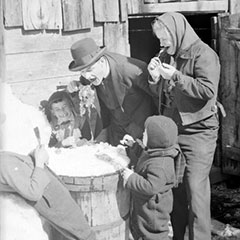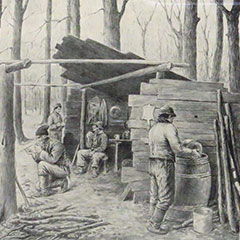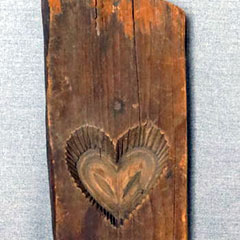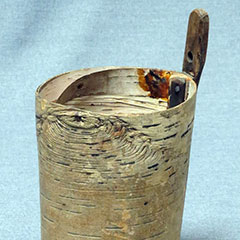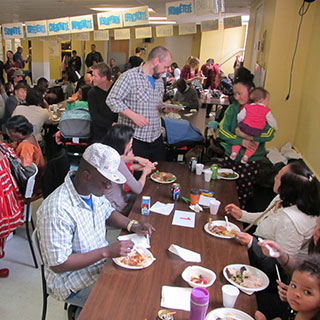Maple Sugar Season
Maple sugar making is generally considered a pleasant activity, even if the sugarhouse is also a place of work, at least in the beginning. Until the middle of the 20 th century, when the Catholic faith was very much part of the way of life in Québec, the sugaring season competed with Lent, during which the Church prescribed a strict fast. This requirement never managed to take this moment of festivity at the end of a long winter away from the people of Québec. Although the context has changed, going to the sugarhouse is still one of Québec’s most popular traditions.
Sugar House
Download video: MP4 , (9,89 MB ), WebM , (10,42 MB ), Ogg (10,44 MB ) (59 seconds)
Video with accordion music presenting a sugar house open year round.
Source: Chez Dany Sugar House
“The delicious golden maple syrup you will have on your table this afternoon has been boiled at 104 degrees.”
An Amerindian Expertise
Amerindians collected maple sap well before Europeans set foot in New France. They taught them their technique at the beginning of the 18 th century. At this time, a great number of sugar makers operated sugarbushes located on the Crown’s land or a seigneury that did not belong to them. A fireplace and temporary shelter were built, then demolished at the end of each sugar making season. It is only during the first half of the 19 th century that the first permanent sugarhouses were built.
Since the 1970s, the sugarhouse has become a commercial business where large groups are welcomed in big dining halls. Collecting the sap under vacuum through tubing has also transformed production. While some sugar makers still maintain the ancient craft, the maple sugar production now relies on modern techniques with an aim for profitability.Going to the Sugarhouse: a Festive Tradition
Quickly, the sugarhouse became a place of leisure: family, friends, and neighbours got together to visit the sugar makers. They could sample maple products and were treated to generous meals. The atmosphere was sometimes livened up with music, song, and dance. Sugaring off parties were quite lively: hide-and-seek games in the woods, snowball fights, rallies, storytelling, and so on. Everything washed down with plenty to drink from the household cellar, which could make or break its reputation.
Spring is the perfect season for love affairs. Consequently, remote sugarhouses, tucked away from supervision, worried self-righteous people to the point that the Sacred-Heart League posted warnings to sugarhouse owners in the L’Action catholique newspaper in March 1949.
Songs of the Sugar Season
Meetings at the sugarhouse are a perfect occasion for singalongs. Historian Marius Barbeau tells about a trip to the sugarhouse that took place in the early 1940s, where the sugar makers sang marches while they traveled. In Notre-Dame-du-Portage, Alcide Léveillée sang:
I met my mistress not long ago
I’ll go and see her on Sunday, oh yes, I will!
I’ll propose to her, I will
In the Bonne Chanson songbooks, Father Charles-Émile Gadbois also talks about the pleasures of a sugar off parties in one of his compositions. In these same songbooks, French poet and author Albert Larrieu, who lived in Canada, also wrote a song about sugarhouses. The popular chorus goes something like this:
Let’s all go to the sugarhouse, oh-oh!
There are never too many people
To taste syrup
Maple syrup!
La cabane à sucre (The Sugar House)
Download audio (2 minutes 56 seconds, 2.69 MB )
Male voice (Albert Viau) singing La cabane à sucre accompanied by a piano.
Composer: Albert Larrieu
Performer: Albert Viau, baritone, 1952
Source: BAnQ – Digital collection [sound recordings]
Slept for months
The sap rises in the branches
A shiver awakens the forest
In our sugar houses
Went all our people
The happy clearing
Echoes from their chants
Spring is on its way.
In our caravan let's go to the sugar house
Oh! eh oh! We're never unwelcomed
To taste the syrup
To taste the maple syrup.
The whole family is here
Everyone wants his share
Here are Hermas and Guillaumette
And Fat Adélard
– Hello Aunt Julie
How are the kids?
– Very good, dear Amélie
We are all happy
For sugar season, what lovely weather we have.
Uncle Damase and Uncle Pierre
Shout loudly, want to hurry
– Put wood under the boiler
You can see the water isn’t hot enough yet.
To lick the spoon
Jeanne runs as fast as she can
While Baptiste and Léonard
Are going for a dip
Only Oscar is by himself.
It's time to take off
The cooking pot from the flames
We'll pour the blond maple taffy
On the snow at the end of the trail
Then under the moonlight
We'll go back home
And I know more than one girl
Who'll choose her husband
Tonight, when they are back home.

